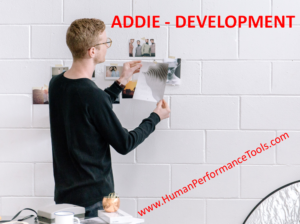The Development Phase of ADDIE: Part 4 of 6
 Instructional designers create and assemble innovative solutions to the training gaps. In the Development - phase of ADDIE, this is where those elements come to life. This is my absolute favorite part of creating training and often allows us to bring in tools to add innovation, fun, engagement, personal interest. Any learner will tell you that it could absolutely be the difference between a mediocre or a great training experience, even with the same goals/objectives in mind. This is the ultimate test of creativity for an Instructional Designer to apply the most ideal solutions for how the students will learn best, ESPECIALLY when the constraints are stacked against you: lack of time, cramped training space, amount of students, etc.
Instructional designers create and assemble innovative solutions to the training gaps. In the Development - phase of ADDIE, this is where those elements come to life. This is my absolute favorite part of creating training and often allows us to bring in tools to add innovation, fun, engagement, personal interest. Any learner will tell you that it could absolutely be the difference between a mediocre or a great training experience, even with the same goals/objectives in mind. This is the ultimate test of creativity for an Instructional Designer to apply the most ideal solutions for how the students will learn best, ESPECIALLY when the constraints are stacked against you: lack of time, cramped training space, amount of students, etc.
In the Development-phase we need to actually do the work we've set out to create:
First, we have assessed our needs for the course, and then we figured out what the course is intended to accomplish - now comes the HOW part of the equation. How are we going to transfer the identified knowledge, skills, or attitudes at the appropriate taxonomy level of detail and intensity? How will we ensure inclusion and engagement for the best student experience?
- Analysis
- Design
- Development
- Implementation
- Evaluation
So, what is actually Developed?
For a new twist on how to ensure the development phase is all-inclusive, let's do some travelling. Mnemonics are fun, and I thought I  would finally create my first - let's take a trip to Africa; "MADAGASCAR" to be precise:
would finally create my first - let's take a trip to Africa; "MADAGASCAR" to be precise:
M: Media - Find or create all audio and/or video planned for the project. Narration and short movie clips are certain to enhance the final product and break up the content into a multimedia approach that students of all ages will appreciate.
A: Activities - The students may be performing including tools and handouts for the classroom
D: Delivery methods - Instructor-led, self-taught, video or eLearning?
A: Align technology to the training - If eLearning, which software will you use? Will you be using audience response system clickers in the classroom? If so, which ones?
G: Graphics associated with the course - create or buy pictures, drawings, photos, diagrams, etc. that will enhance the content.
A: Assignments - What will the students be doing as pre-work, classwork, or homework, and what equipment, resources, or handouts are necessary to assist?
S: Storyboards - Lay out the final revision of the course flow. These are somewhat different than the Design-phase Storyboards in that these are the final revisions.
C: Content - Ensure nothing is left out, all objectives are addressed within the lesson plan.
A: Assessments - Create the tool for knowledge transfer to be proven?
R: Review and Revise - Before development is complete, ensure Subject Matter Experts have an opportunity to give some feedback on the course.
Conclusion
As we make our way to the implementation-phase, we should revel in the complexities that have been worked through up until this point. The course is mostly created and may need some checking and adjusting, but it has a lot more than objectives and ideas. We are ready to pilot the course now - beta test here we come!
Some pretty great links you may like related to this phase of ADDIE:
Getting to know ADDIEADDIE Development phase in WikipediaReflections on Learning SuccessADDIE Development phase - Intulogy